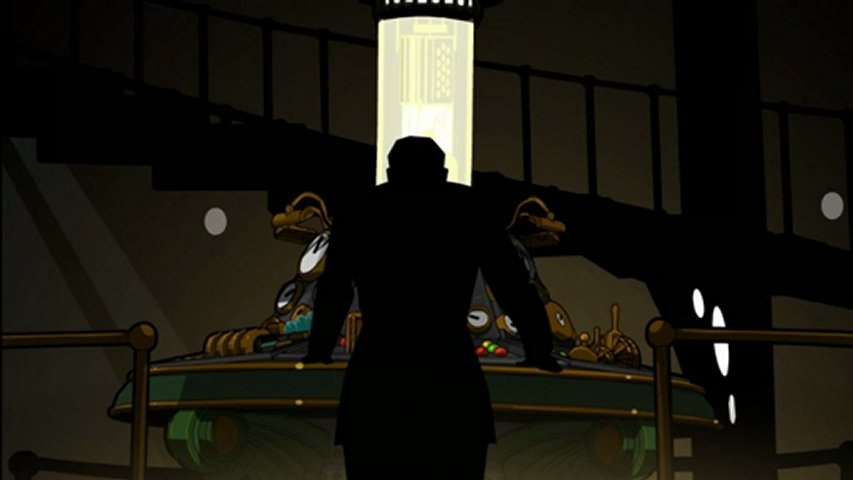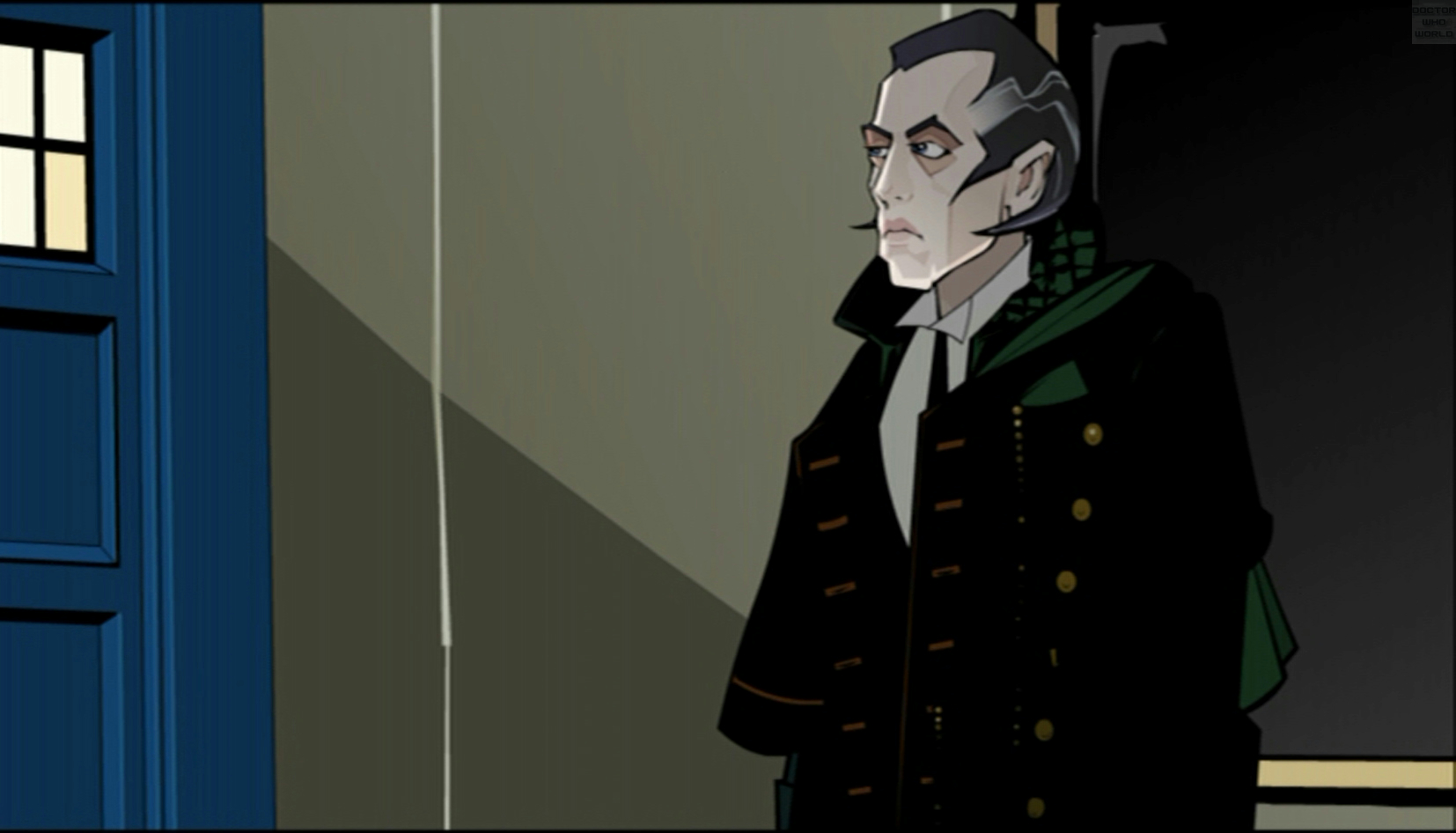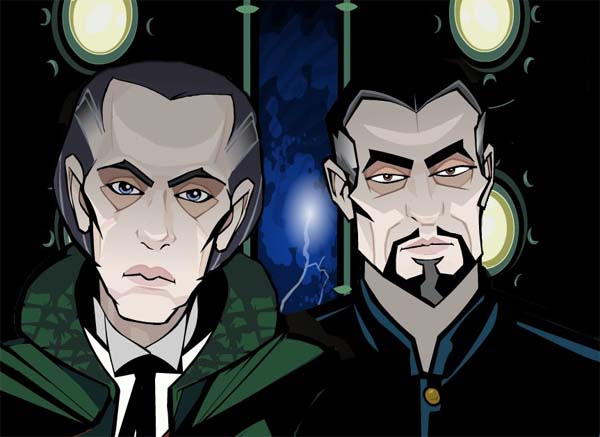Before the series returned in 2005, a special Doctor Who animation was commissioned. This was meant to pave the way for a whole new season of adventures, with the actor Richard E. Grant at the controls of the TARDIS. But why was it abandoned after just six episodes?

As Doctor Who‘s 40th anniversary approached in 2003, the team at BBCi (who had been responsible for much of Doctor Who‘s online presence) discovered that the BBC didn’t have anything to mark the show’s birthday. As a result, plans were quickly drawn up to produce a brand new Doctor Who animation that could be streamed online – an ambitious idea, given that this was in the age of 56k modems.
But technology notwithstanding, it soon became clear that producing a Doctor Who animation would have other challenges. According to the documentary on the BBC’s ‘Scream of the Shalka’ DVD, the production team couldn’t work out what the rights situation was. Were they actually allowed to produce new Who? It seemed that the BBC didn’t know, either. Some people said that the rights to the Daleks were creating a sticking point. Others thought that BBC Worldwide held the rights, as they were trying to produce a Doctor Who movie.
Eventually, however, the Doctor Who animation project was given the greenlight; as far as anyone could tell, BBCi was allowed to create new Doctor Who episodes without being summoned to the Gallifreyan courtroom. Moreover, it seemed as if there was little appetite to produce Doctor Who in any other medium. The show’s future, it seemed, would be all-digital; from now on, Doctor Who would be restricted to the internet, in cartoon form.

With this in mind, the team at BBCi started planning their Doctor Who animation in earnest. They enlisted the help of writer Paul Cornell, who had already penned a number of successful Virgin novels for the franchise, and drew up plans for an ambitious, twelve-part season made up of three, four-part stories.
Alas, producing a Doctor Who animation was never going to be cheap, and the team quickly discovered that they would need to rein in their plans if they were to make the series without re-mortgaging their TARDISes. As such, the epic twelve-part Season 27 quickly became six, and would tell a single story – a brand new adventure with a brand new Doctor for the show’s 40th anniversary. Titled ‘Scream of the Shalka,’ it would be streamed exclusively on the official Doctor Who website.
Reaction to the project’s announcement, however, was mixed. According to the BBC documentary, some fans were delighted that they would be getting a new form of their favourite show in time for its birthday. On the other hand, some people were upset that it was just an animated project; ‘Shalka’ seemed to be the final nail in the coffin for their dreams of a brand new TV series.
Despite this, the new Doctor Who animation moved ahead in full vigour. Richard E. Grant took the TARDIS keys and headed to the recording studio, joined by an impressive cast which included Derek Jacobi as the Master, and – surprisingly – David Tennant as the pivotal character of Warehouse Man Number Two, as he just happened to be working in adjoining studio, and was desperate to be involved.

Meanwhile, the animation itself was handed over to the production company Cosgrove Hall, who began stitching the project together as soon as they had the audio guide tracks. Interestingly, the fact that this Doctor Who animation was to be streamed online posed a number of creative challenges. BBCi wanted to deliver it without any ‘loading screens,’ and Cosgrove Hall achieved this by inserting carefully-disguised long-shots into the middle of the episodes, which would play out as the subsequent scenes were being buffered. In effect, the viewer would be looking at a loading screen without knowing.
It was at this point that Lorraine Heggessey – the Controller of BBC One – caught wind of the Doctor Who animation. Apparently she, like everyone, had thought that it was impossible to create new Doctor Who owing to the rights issues, and was surprised when she learned of the investigations done by BBCi, which proved that there were no rights problems at all. Suddenly, the possibility of making a brand new series of Doctor Who was not so far-fetched.
This realisation was great news for fans of the programme, but it spelled doom for the Doctor Who animation. Within weeks, it was announced that Doctor Who would be returning to BBC One in 2005, overseen by long-time fan and writer Russell T. Davies. It was the best present that any fan could have wished for in the show’s 40th anniversary year, but it didn’t bode well for ‘Scream of the Shalka.’ At this point, it hadn’t even been released – and it looked as if it would be ‘outdated’ before it had aired.
Despite this, ‘Scream of the Shalka’ did finally arrive on the official Doctor Who website on the 13th November 2003, and was ‘broadcast’ weekly until mid December. It may not have paved the way for a brand new cartoon series, but its impact on the Whoniverse cannot be overlooked.
For a start, had the team at BBCi not investigated the rights situation, they might not have attracted the attention of Lorraine Heggessey. Moreover, ‘Scream of the Shalka’ became something of a milestone in the history of the programme, standing as the first official, full-length Doctor Who animation that paved the way for the recreation of the unfinished Tom Baker story ‘Shada,’ and the Tenth Doctor adventure ‘Dreamland.’
As such, ‘Shalka’ proved that Doctor Who animation could be successful, and Cosgrove Hall returned to the franchise in 2006 to recreate the missing episodes of the Second Doctor story ‘The Invasion.’ And today, cartoons have become the standard for breathing new life into old stories. We now have complete animated versions of ‘The Power of the Daleks,’ ‘Fury from the Deep,’ ‘The Macra Terror’ and ‘The Faceless Ones,’ with more stories on the horizon.
And whilst few Doctor Who fans would choose a Doctor Who animation over a live action TV series, it is fascinating to wonder what a cartoon Season 27 would have been like. What kinds of adventures would Richard E. Grant’s Doctor have had under the guidance of Paul Cornell and BBCi? And what would Doctor Who look like today if the animated format had become the norm?
We may need a TARDIS to find out…

Seventh Doctor Paisley hanky – order now from the Lovarzi shop!
Shop on Amazon
Latest posts…
- The unofficial Doctor Who Christmas specials
- Doctor Who: 5 reasons to watch The Christmas Invasion
- The strangest Doctor Who missing episode discoveries
- Which Doctor Who story should they edit next?
- Doctor Who Season 12 merch materialises at Lovarzi

I enjoyed it at the time (it’s probably due a rewatch) and I remember thinking that, as a story, it had a lot of strengths – and, not to mention, a very good cast. Richard E, Grant delivered and Sophie Okandeno, as a companion, had much more nuance than many who both preceded and followed her We also go a glimpse of the future with Derek Jacobi; who, to me, is still the perfect casting as the Master after Roger Delgado,
If NuWho had continued in this vein as a live-action show, I wouldn’t have been disappointed, to be honest.